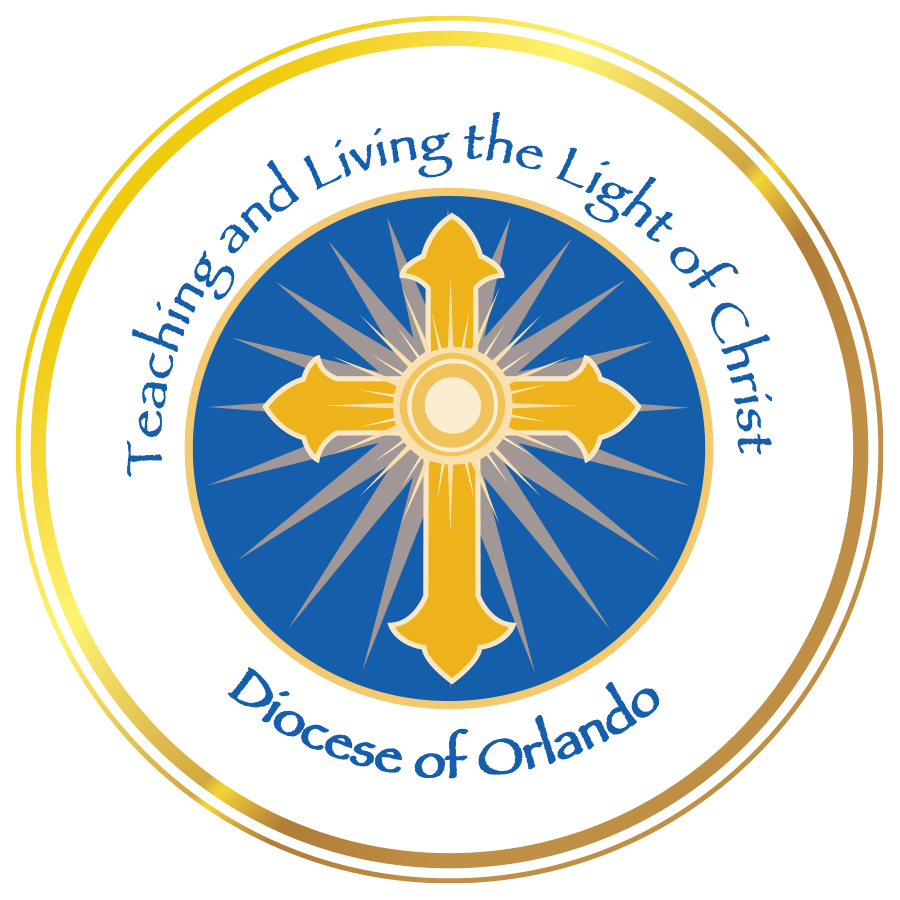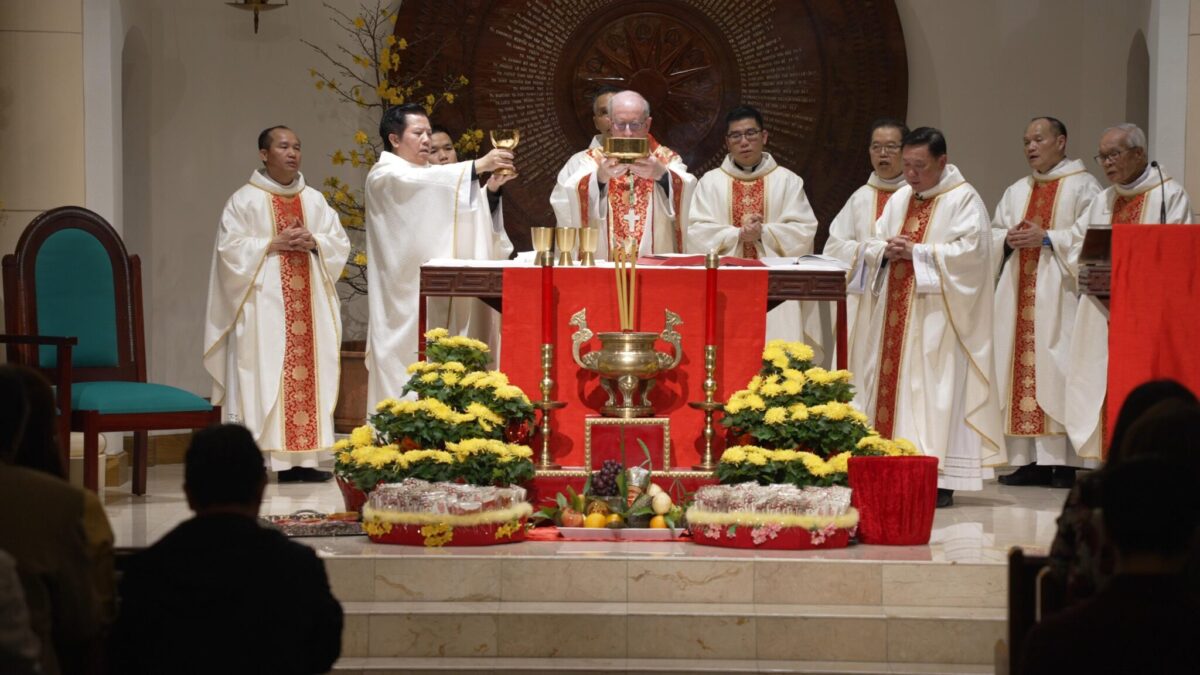ORLANDO | From a distance, it is as if peering through a kaleidoscope of activities seemingly unrelated to Catholicism or one’s common experience within the context of a Catholic Mass. Vivid colored clothing, fruit, special cakes and red envelopes are key to the Vietnamese celebration of the Lunar New Year known as Tet. On Jan. 21, the St. Philip Phan Van Minh community gathered for this cultural celebration during a Mass that includes the remembrance of ancestors, gratitude, and hope for the new year.
This cultural integration is the very essence of the presence of Christ incarnate, coming to each culture and speaking through it.
According to Pope Paul I’s document Gaudium et Spes, “There are many ties between the message of salvation and human culture. For God, revealing Himself to His people to the extent of a full manifestation of Himself in His Incarnate Son, has spoken according to the culture proper to each epoch” (Chapter 2, 58).

GRP STUDIOS | FC
Father Chau Nguyen, pastor of St. Philip Phan Van Minh, relates to this connection. “Vietnamese are theistic people. They always believe in a divine being, whose providential care is abundant to all on earth,” he said. “Also, being an agrarian society, they are very much dependent on the heavens to provide sun and rain for the crops. The Gospel speaks of a God whom the Vietnamese people already encountered. It presents a God who provides everything they need” (Mt 6:25-34).
Moreover, the Mass is a Eucharistic feast. Eucharist means thanksgiving, and this action is the bedrock of the Vietnamese Lunar New Year Mass.
“Aspects of culture being inculturated in the Liturgy enhance the worship and closeness to God,” Father Nguyen said. An example is the gifts brought up at the offertory — a tray of five fruits recognizes the first fruits of their labor. The bánh chưng and bánh tét — square and cylindrical cakes, which represent heaven and earth, are also brought up,” he explained. “These cakes are made for the New Year as significant symbols of harmony. The Mass is said in Vietnamese, allowing the people to pray “in a language so close to their hearts in praising and thanking God.”
Lily Phuong Duong arrived in the United States in 1987, at age 19. She was Buddhist and in her country her family had their own temple. Ten years after being in America, she converted to Catholicism and married a Vietnamese Catholic. The integration of Vietnamese culture at St. Philip Phan Van Minh is a reminder of her Vietnamese heritage and God’s presence is a part of it.
“I believe that any culture has a common fact, gratitude,” she said.
The idea is ingrained through lullabies and fictional stories. She said regardless of who we are, or what role we carry as we grow up, “each one of us, regardless of religions, was taught to appreciate the Lord who gives us everything in our life.”
She recalled the lyrics of one of the lullabies: “Pray to the Lord for raining days, to use the rainwater to drink, for better soils for our crops, for full bowls of rice, for hay to cook meals.” She said feeling more reliant on God is conducive to living with a deeper appreciation of Him.
Another tradition of the New Year Mass is to light incense sticks “to pay respect to ancestors and to thank the Lord for a new day with good business, good crops to harvest.”
“(It teaches Vietnamese people) to live like a tree that has deep roots, like spring water that knows its origin, like a human being who has ancestors; a culture that teaches us to pay respect and appreciation to the Lord and to parents, grandparents, great grandparents, our ancestors,” Duong said.
As stated in Lumen Gentium, honoring ancestors is a way of “cultivating the memory of those who have gone before us and have marked the way for us.” During Tet, this is done through intentional gatherings with family, joyful celebrations, and sharing of traditional foods. Through the Mass offerings, music and prayers, a reflection on the recent past is an opportunity for gratitude and “pray God continues to embrace us in His arms for good health, peace and especially His grace,” Duong said.
Still, some might ask why this inculturation is necessary. If we are all united in the body of Christ, why do some celebrations of the Mass look so different, such as the Hispanic use of lazos in weddings symbolizing two becoming one, or a handing of coins to indicate a commitment to provide for a spouse?
Isabel Fernandez, director of Faith Formation for the Diocese of Orlando explained, “Every expression of our faith is connected to some culture because it all comes from humans and we are all culturally bound.” She said all cultures see God in different ways “because God pays attention to culture and wants to be present to us.”
In acknowledging the mission of the Church to bring Christ to others and the message of the Gospel into different places, she said there is supposed to be a dialogue between the culture and the Gospel. “Part of the task is to find Christ in both so that the Word, the people, and the culture speak to each other. Out of that, traditions of local areas find their way into the liturgy or devotional practices.” She said, “The Church walks with people and learns from the people, a different way to see Christ in a different situation and in a different location we hadn’t encountered Him before.” And of course, none of this occurs without the Holy Spirit.
“For Christian faith, the unity of all in their origin and destiny, that is, in creation and in communion with God in Jesus Christ, is accompanied by the universal presence and action of the Holy Spirit.” (Faith and Inculturation, 1988). The Church in dialogue listens and learns. “The Catholic Church rejects nothing that is true and holy in these religions. She regards with sincere reverence those ways of conduct and of life, those precepts and teachings which, though differing in many aspects from the ones she holds and sets forth, nonetheless often reflect a ray of that truth which enlightens all men” (Nostra Aetate,2).
“We’ve been doing this since we started. All of the different cultures that have come in contact with the Gospel, find ways of finding Christ in some of their old traditions. As the Church, in conversation with people, is always discovering that, we’re always discovering Christ anew,” Fernandez said. “It’s who we are. It’s the very foundation of having a Church that is worldwide — that doesn’t see itself as one thing, but as all things. We’re just following Christ’s example.”
By Glenda Meekins of the Florida Catholic staff, January 27, 2023

